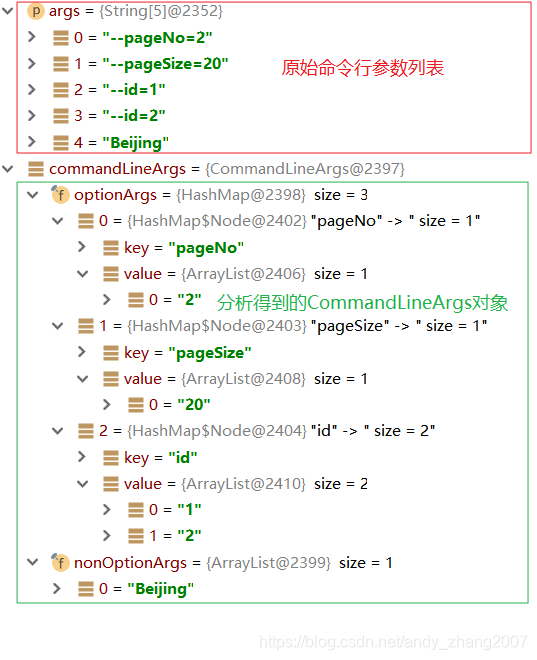本文代码基于
Springboot 2.1.0
概述
Spring对应用程序运行的命令行参数进行了抽象,这个抽象是类CommandLineArgs。
CommandLineArgs类将命令行参数分为两类:
- option 参数
- 以
--开头 - 可以认为是
name/value对参数 - 例子 :
--foo, --foo=bar
- 以
- 非 option 参数
- 不以
--开头 - 可以认为是只提供了value的参数(具体怎么理解这个值,看业务逻辑的需求)
- 不以
源代码解析
其源码如下:
package org.springframework.core.env;
import java.util.ArrayList;
import java.util.Collections;
import java.util.HashMap;
import java.util.List;
import java.util.Map;
import java.util.Set;
import org.springframework.lang.Nullable;
class CommandLineArgs {
private final Map<String, List<String>> optionArgs = new HashMap<>();
private final List<String> nonOptionArgs = new ArrayList<>();
/**
* Add an option argument for the given option name and add the given value to the
* list of values associated with this option (of which there may be zero or more).
* The given value may be {@code null}, indicating that the option was specified
* without an associated value (e.g. "--foo" vs. "--foo=bar").
* 添加option参数,例如 --foo, --foo=bar 这样的参数
* 同名option参数可以有多个值,比如同时提供了 --id=1 --id=2 这样的参数
*/
public void addOptionArg(String optionName, @Nullable String optionValue) {
if (!this.optionArgs.containsKey(optionName)) {
this.optionArgs.put(optionName, new ArrayList<>());
}
if (optionValue != null) {
this.optionArgs.get(optionName).add(optionValue);
}
}
/**
* Return the set of all option arguments present on the command line.
* 获取所有option参数的名称列表
*/
public Set<String> getOptionNames() {
return Collections.unmodifiableSet(this.optionArgs.keySet());
}
/**
* Return whether the option with the given name was present on the command line.
* 是否包含某个指定名称的option参数
*/
public boolean containsOption(String optionName) {
return this.optionArgs.containsKey(optionName);
}
/**
* Return the list of values associated with the given option. null signifies
* that the option was not present; empty list signifies that no values were associated
* with this option.
* 获取指定名称的option参数的值,如果命令行中没有这个option参数,返回null;
* 因为一个option参数可能会被指定多个值,所以返回的是一个列表
*/
@Nullable
public List<String> getOptionValues(String optionName) {
return this.optionArgs.get(optionName);
}
/**
* Add the given value to the list of non-option arguments.
* 增加一个非option参数,一个非option参数可以被认为是只有value的一个参数,
*/
public void addNonOptionArg(String value) {
this.nonOptionArgs.add(value);
}
/**
* Return the list of non-option arguments specified on the command line.
* 返回所有非option参数
*/
public List<String> getNonOptionArgs() {
return Collections.unmodifiableList(this.nonOptionArgs);
}
}
通过例子说明用途
当我们使用springboot开发一个应用时,假如我们为应用程序提供了命令行参数--pageNo=2 --pageSize=20 --id=1 --id=2 Beijing,通过这个命令行参数我们想告诉应用程序的是:找出Beijing地区,用户id为1或者2的所有订单记录,返回结果集中的第二页,每页容量为10行数据。针对该例子,实际上springboot就将其封装成了一个CommandLineArgs对象:
// SpringApplication 类源代码部分
public ConfigurableApplicationContext run(String... args) {
StopWatch stopWatch = new StopWatch();
stopWatch.start();
ConfigurableApplicationContext context = null;
Collection<SpringBootExceptionReporter> exceptionReporters = new ArrayList<>();
configureHeadlessProperty();
SpringApplicationRunListeners listeners = getRunListeners(args);
listeners.starting();
try {
ApplicationArguments applicationArguments = new DefaultApplicationArguments(
args);//<=== 构造一个应用程序参数对象,输入参数是命令行参数列表(String[]类型)
ConfigurableEnvironment environment = prepareEnvironment(listeners,
applicationArguments);
// DefaultApplicationArguments类代码片段
public DefaultApplicationArguments(String[] args) {
Assert.notNull(args, "Args must not be null");
// Source 是一个 DefaultApplicationArguments 静态内部类,继承自 SimpleCommandLinePropertySource
this.source = new Source(args); //<==== 继续传递原始命令行参数列表
this.args = args;
}
// SimpleCommandLinePropertySource 代码片段
public SimpleCommandLinePropertySource(String... args) {
// 使用一个SimpleCommandLineArgsParser对象分析原始的命令行参数列表,返回结果类型为CommandLineArgs
super(new SimpleCommandLineArgsParser().parse(args));
}
实际上,SimpleCommandLineArgsParser其实是Spring的一个命令行参数列表分析工具,它的目的就是将原始的命令行参数列表分析处理后保存为一个CommandLineArgs对象。就上面的例子而言,最终的CommandLineArgs对象如下:

留意上面例子中关于多值option参数的处理







 本文深入解析SpringBoot如何处理命令行参数,介绍CommandLineArgs类的使用,区分option与非option参数,展示如何通过SpringBoot读取和使用这些参数。
本文深入解析SpringBoot如何处理命令行参数,介绍CommandLineArgs类的使用,区分option与非option参数,展示如何通过SpringBoot读取和使用这些参数。
















 847
847

 被折叠的 条评论
为什么被折叠?
被折叠的 条评论
为什么被折叠?








